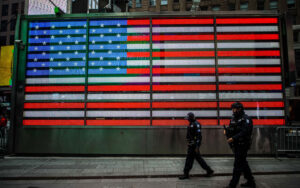
September 30, 2019; Jacobin
Social learning, learning by paying attention to what others do, is central to human evolution. It is no less important in social movements. Yet it can often clash with the desire to protect those in the in-group and the relationships upon which the movements are built. This is reflected in the desire many have had to learn from recent movements, like Black Lives Matter, and the reality that, though people may speak off the record, generally those who know the lessons don’t want to talk. What happens in movement stays in movements.
Not so with Keeanga-Yamahtta Taylor, professor of African-American Studies at Princeton University, whose recent article, “Five Years Later, Do Black Lives Matter?,” may begin to shed some light.
In a sense, the issue of learning from movements is a chicken-and-egg dilemma. Taylor writes, “The goodwill that many imagined and wanted to rest at the heart of the movement could only be built upon trust and genuine relationships. These were difficult to build without formal structures, clear responsibilities, and mechanisms for leadership and accountability.”
This calls to mind Hardt and Negri’s assertion, in their latest book Assembly, that the core leadership challenge today for social movements is organization. They call for what they refer to as non-sovereign leadership and identify its two primary tasks as “how to construct organizations without hierarchy, and how to create institutions without centralization.” They agree with many others who say that this requires a different space: “We need to leave the noisy sphere of politics, where everything takes place on the surface, and descend into the hidden abode of social production and reproduction.”
In other words, today’s social change requires social production, the creation of new identities and ways of being. Politics, while important, keeps us at the surface.
To be sure, the Black Lives Matter movement faces external challenges. One is its status as a rallying point for a growing white supremacist (really nationalist) movement and the concomitant harassment and death threats faced by its leaders, who were labeled “black identity extremists” for fighting for the right to not be killed. Some appear to actually have been murdered.
The other big external challenge, which according to Taylor is even trickier, are “the maneuvers of the Democratic Party establishment in its efforts to divide the movement between the pragmatists and those who were rapidly radicalizing in the face of intransigent police power.” This was mirrored in “the influence of nongovernmental organizations, which measure the effectiveness of activism or organizing through a sense of efficiency and tangible results.”
These exacerbated internal tensions, which are not new, about how radical change is achieved. Namely, the assumption that maturity means shifting from protest to policy and political power, or working within the system. But, Taylor writes, many activists were moving beyond holding the police system and the wider criminal justice system accountable to structural change:
Some were embracing the politics of abolition and the belief that society would be better off without the entire carceral system. Instead of spending $80 billion a year to put human beings in cages, maybe those resources could be redistributed in such a way as to make people’s lives better instead of being used to punish.
Further, Taylor observes that movement exposed sharp divisions between “the class anger of black workers and the class optimism of a tiny elite.” Namely, the fact that in many cases, black political leaders, black police chiefs, and police officers oversaw the inequality and oppression that fueled Black Lives Matter. She writes, “Local and national black elected officials have betrayed their constituents by way of institutional neglect and then have relied on brutal policing to manage the ensuing crisis.”
Sign up for our free newsletters
Subscribe to NPQ's newsletters to have our top stories delivered directly to your inbox.
By signing up, you agree to our privacy policy and terms of use, and to receive messages from NPQ and our partners.
Regarding the movement itself, Taylor notes that it lived more in the hearts and mind of young people “who ached to be heard and seen” rather than in its formal organization. As a result, there was no process for figuring out political disagreements.
The lack of clear entry points into movement organizing, and the absence of any democratically accountable organization or structure within the movement, left very few spaces to evaluate the state of the movement, delaying its ability to pivot and postponing the generalization of strategic lessons and tactics from one locality to the next or from one action to the next.
[…]
The BLM movement claimed to have no leaders, embracing the “horizontalism” of its Occupy predecessor. But all movements have leaders; someone or some group of individuals are deciding that this or that thing will or will not happen; someone decides how this or that resource is used or not used; someone decides whether this or that meeting will or will not happen. The issue is not whether there are leaders, it is whether those leaders are accountable to those they represent. It also matters the way in which those leaders are determined as leaders.
For Taylor, the result of all this is to make “the inside political game seem like a more viable way forward,” especially with any formal organizations backed by foundations looking for results, moderation, and compromise. So, while the movement did lead to a policy platform, Taylor asks, “Without a social movement on the ground to create the muscle necessary to coerce the political establishment to shift from its intransigence, how would any of it become achievable?”
For Taylor, the increasing ability to secure funding “undermined the potential of developing more democratic practices within the movement by giving those with the access to funding an outsize voice.”
This under-sourcing of truly democratic practices affects not only our ability to participate, but to learn and evolve. Taylor writes, “It raises the crucial question of how organizers emerge from a lost battle or even a lost war with more clarity about their experience, the lessons learned, and salvaged relationships that may allow them to fight another day with a better sense of what to do the next time around.”
A focus on wider participation in the movement—more contact between the different layers and political spaces where these layers could influence each other—would have kept the focus on mass mobilization, the critical goal of which is not its impact on the state, “but on those who participate,” who become political actors. She concludes that the point of social movements is to “create arenas where we, ourselves, can be transformed.”
For Taylor, while the movement has brought state-sanctioned violence to light, and many of its organizers continue the work in other forms, “the mass movement that captured the attention of the world and upended the status quo does not exist in the same way.” And being killed by police is still a leading cause of death for young black men.
Nevertheless, she observes, “The questions of strategy, tactics, and democracy that emerged as a consequence of the rise of the Black Lives Matter movement have not gone away; in fact, they remain critical to determining how we transform our current situation.”
These are potent observations and brave to be told. Perhaps the real sign of movement is the ability to reflect on itself openly this way.—Cyndi Suarez













